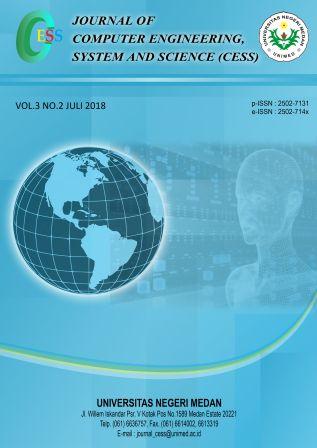DATA INTEGRATION MODEL DESIGN FOR SUPPORTING DATA CENTER PATIENT SERVICES DISTRIBUTED INSURANCE PURCHASE WITH VIEW BASED DATA INTEGRATION
DOI:
https://doi.org/10.24114/cess.v3i2.8895Abstract
Data integration is an important step in integrating information from multiple sources. The problem is how to find and combine data from scattered data sources that are heterogeneous and have semantically informant interconnections optimally. The heterogeneity of data sources is the result of a number of factors, including storing databases in different formats, using different software and hardware for database storage systems, designing in different data semantic models (Katsis & Papakonstantiou, 2009, Ziegler & Dittrich , 2004). Nowadays there are two approaches in doing data integration that is Global as View (GAV) and Local as View (LAV), but both have different advantages and limitations so that proper analysis is needed in its application. Some of the major factors to be considered in making efficient and effective data integration of heterogeneous data sources are the understanding of the type and structure of the source data (source schema). Another factor to consider is also the view type of integration result (target schema). The results of the integration can be displayed into one type of global view or a variety of other views. So in integrating data whose source is structured the approach will be different from the integration of the data if the data source is not structured or semi-structured. Scheme mapping is a specific declaration that describes the relationship between the source scheme and the target scheme. In the scheme mapping is expressed in in some logical formulas that can help applications in data interoperability, data exchange and data integration. In this paper, in the case of establishing a patient referral center data center, it requires integration of data whose source is derived from a number of different health facilities, it is necessary to design a schema mapping system (to support optimization). Data Center as the target orientation schema (target schema) from various reference service units as a source schema (source schema) has the characterization and nature of data that is structured and independence. So that the source of data can be integrated tersetruktur of the data source into an integrated view (as a data center) with an equivalent query rewriting (equivalent). The data center as a global schema serves as a schema target requires a "mediator" that serves "guides" to maintain global schemes and map (mapping) between global and local schemes. Data center as from Global As View (GAV) here tends to be single and unified view so to be effective in its integration process with various sources of schema which is needed integration facilities "integration". The "Pemadu" facility is a declarative mapping language that allows to specifically link each of the various schema sources to the data center. So that type of query rewriting equivalent is suitable to be applied in the context of query optimization and maintenance of physical data independence.Keywords: Global as View (GAV), Local as View (LAV), source schema ,mapping schemaDownloads
References
McBrien, Peter, and Alexandra Poulovassilis. "Data integration by bi-directional schema transformation rules." Data Engineering, 2003. Proceedings. 19th International Conference on. IEEE, 2003.
Lenzerini, Maurizio. "Data integration: A theoretical perspective." Proceedings of the twenty-first ACM SIGMOD-SIGACT-SIGART symposium on Principles of database systems. ACM, 2002.
Katsis, Yannis, and Yannis Papakonstantinou. "View-based data integration." Encyclopedia of Database Systems. Springer US, 2009. 3332-3339.
Kolaitis, P. G. (2009). Relational Databases, Logic, and Complexity [Powerpoint slides]. Retrievedfrom https://users.soe.ucsc.edu/~kolaitis/talks/gii09-final.pdf
] Hellerstein, Joseph M., Michael Stonebraker, and James Hamilton. "Architecture of a database system." Foundations and Trends® in Databases 1.2 (2007): 141-259.
Miller, Renée J., Laura M. Haas, and Mauricio A. Hernández. "Schema mapping as query discovery." VLDB. Vol. 2000. 2000.
Ullman, Jeffrey D. "Information integration using logical views." International Conference on Database Theory. Springer, Berlin, Heidelberg, 1997.
Levy, Alon, Anand Rajaraman, and Joann Ordille. Querying heterogeneous information sources using source descriptions. Stanford InfoLab, 1996.
Genesereth, Michael R., Arthur M. Keller, and Oliver M. Duschka. "Infomaster: An information integration system." ACM SIGMOD Record. Vol. 26. No. 2. ACM, 1997.
Calvanese, Diego, Domenico Lembo, and Maurizio Lenzerini. "Survey on methods for query rewriting and query answering using views." Integrazione, Warehousing e Mining di sorgenti eterogenee 25 (2001).
Landers, Terry, and Ronni L. Rosenberg. "An overview of Multibase." Distributed systems, Vol. II: distributed data base systems. Artech House, Inc., 1986.
Ullman, Jeffrey D. "Database and Knowledge-Base Systems, Volumes I and II." (1989).
Abiteboul, Serge. "Foundations of Databases/Serge Abiteboul, Richard B. Hull, and Victor Vianu." (1995).
Nurhendratno, Slamet Sudaryanto, and Fikri Budiman. "DESIGN MODEL INTEGRATION AND SYNCRONIZATION BETWEEN SURVEILLANCE UNITS TO SUPPORT DATA WAREHOUSE EPIDEMIOLOGY." Journal of Theoretical and Applied Information Technology 95.3 (2017): 498.
Published
How to Cite
Issue
Section
License
Copyright (c) 2018 CESS (Journal of Computer Engineering, System and Science)

This work is licensed under a Creative Commons Attribution 4.0 International License.















